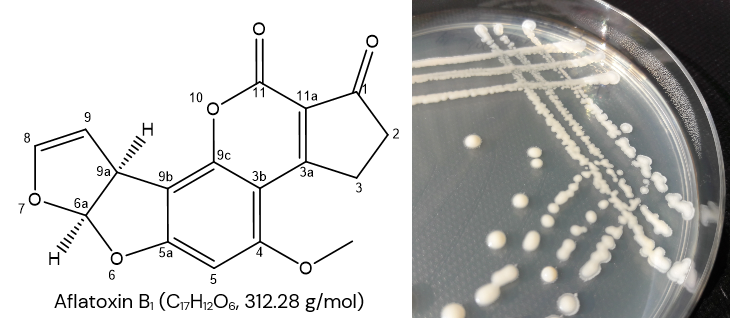Aflatoxins are carcinogenic mycotoxins which recurrently contaminate human food and animal feed. They are produced by the mould fungi Aspergillus flavus and A. parasiticus. These fungi proliferate in warm climate, and there are indications that global warming is exacerbating the aflatoxin contamination problem. Crops including peanuts, tree nuts and maize from warm growing regions are notorious for aflatoxin contamination. Cases of acute human poisoning, including cases with fatal outcome, are documented. However, much more prevalent is chronic exposure, which is known to correlate with hepatocellular carcinoma, in particular when combined with hepatitis B infection. Subsistence farming communities in sub-Saharan Africa and South Asia are particularly affected.
Farm animals are also recurrently exposed, and even low-level aflatoxin contamination in feed weakens pigs, poultry, cattle and fish, reducing growth and reproductive performance, and increasing susceptibility to infectious diseases. As aflatoxin can enter the human food chain through animal products including milk, regulatory maximum tolerable contamination levels have been defined by many countries. Such regulatory limits, both for food and feed, can inadvertently also have an economic effect and act as trade barriers, often to the disadvantage of less developed countries offering agricultural exports. Aflatoxin exposure mitigation measures include non-aflatoxigenic Aspergillus strains as microbiological competitors in the field, and physical sorting. For animal feed, the conventional mitigation method is based on the use of certain bentonite clays of the smectite type as feed additive. Such adsorption technology is effective in reducing, but not preventing aflatoxin exposure of animals, as is known from studies were concentrations of biomarkers of aflatoxin exposure were analysed. Microbiological and enzymatic conversion of aflatoxin has been investigated, but no such detoxification technology has yet been established.
The long-term goal of the project is to establish enzyme technology for degradation and detoxification of aflatoxin in feed or food. The immediate goal is to elucidate the aflatoxin degradation pathway of Rhodococcus erythropolis. The ability of strains of R. erythropolis to degrade aflatoxin has been described in scientific literature and confirmed by us. However, the genes and enzymes responsible for degradation have not yet been identified. Molecular biology techniques, including functional knock-out mutagenesis, will be used to identify key genes. Key enzymes will be produced by heterologous gene expression, and purified. Enzyme characterisation will include pre-steady-state kinetic methods to determine rate-limiting steps of the catalytic cycle, to compare with known enzymes including F420-dependent oxidoreductases and laccases, and to assess the potential for application in enzymatic detoxification technologies. The microbiology, molecular biology, biochemistry, and enzymology work for the project will mostly be conducted in the laboratories of Biomin Holding GmbH (dsm-firmenich) in Tulln, Austria. Analytical methods for detection and quantification of aflatoxin-derived metabolites as intermediates of the catabolic pathway will be developed at the Institute of Bioanalytics and Agro-Metabolomics of BOKU University Vienna (Tulln, Austria), and the toxicity of such metabolites will be investigated at the INRAE Toulouse (France).

